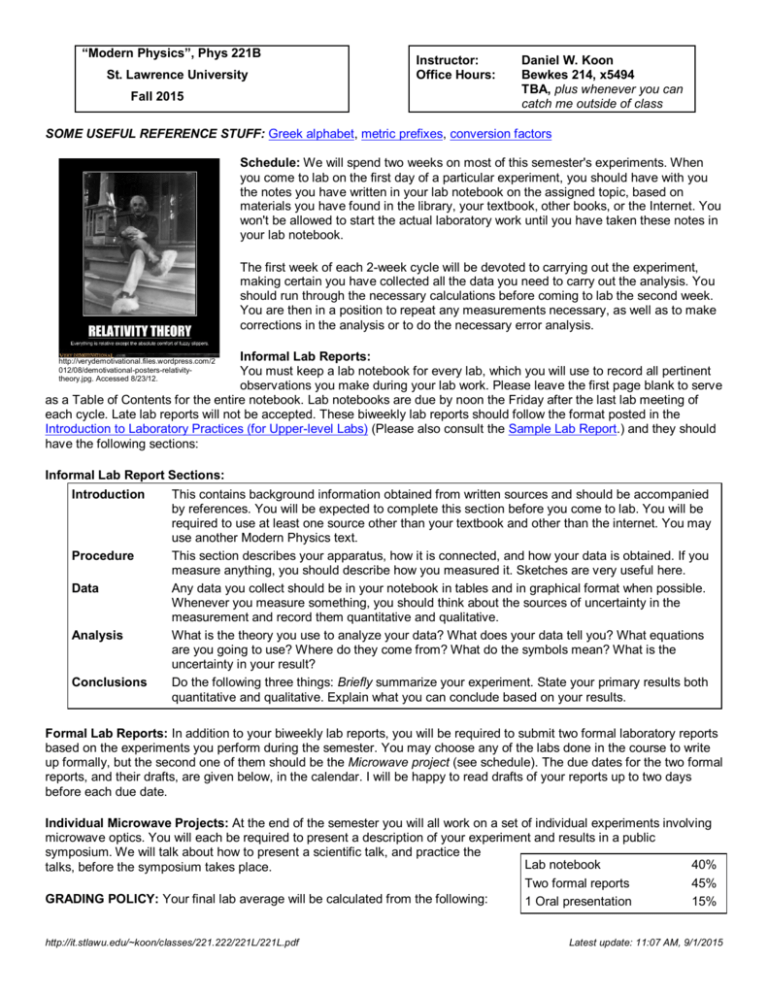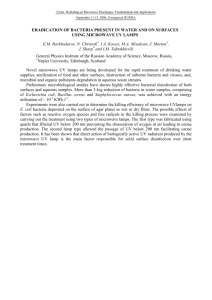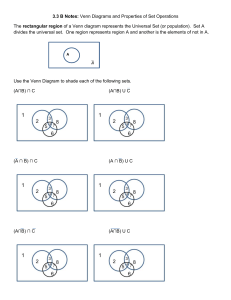“Modern Physics”, Phys 221B St. Lawrence University Fall 2015
advertisement

“Modern Physics”, Phys 221B St. Lawrence University Fall 2015 Instructor: Office Hours: Daniel W. Koon Bewkes 214, x5494 TBA, plus whenever you can catch me outside of class SOME USEFUL REFERENCE STUFF: Greek alphabet, metric prefixes, conversion factors Schedule: We will spend two weeks on most of this semester's experiments. When you come to lab on the first day of a particular experiment, you should have with you the notes you have written in your lab notebook on the assigned topic, based on materials you have found in the library, your textbook, other books, or the Internet. You won't be allowed to start the actual laboratory work until you have taken these notes in your lab notebook. The first week of each 2-week cycle will be devoted to carrying out the experiment, making certain you have collected all the data you need to carry out the analysis. You should run through the necessary calculations before coming to lab the second week. You are then in a position to repeat any measurements necessary, as well as to make corrections in the analysis or to do the necessary error analysis. Informal Lab Reports: You must keep a lab notebook for every lab, which you will use to record all pertinent observations you make during your lab work. Please leave the first page blank to serve as a Table of Contents for the entire notebook. Lab notebooks are due by noon the Friday after the last lab meeting of each cycle. Late lab reports will not be accepted. These biweekly lab reports should follow the format posted in the Introduction to Laboratory Practices (for Upper-level Labs) (Please also consult the Sample Lab Report.) and they should have the following sections: http://verydemotivational.files.wordpress.com/2 012/08/demotivational-posters-relativitytheory.jpg. Accessed 8/23/12. Informal Lab Report Sections: Introduction Procedure Data Analysis Conclusions This contains background information obtained from written sources and should be accompanied by references. You will be expected to complete this section before you come to lab. You will be required to use at least one source other than your textbook and other than the internet. You may use another Modern Physics text. This section describes your apparatus, how it is connected, and how your data is obtained. If you measure anything, you should describe how you measured it. Sketches are very useful here. Any data you collect should be in your notebook in tables and in graphical format when possible. Whenever you measure something, you should think about the sources of uncertainty in the measurement and record them quantitative and qualitative. What is the theory you use to analyze your data? What does your data tell you? What equations are you going to use? Where do they come from? What do the symbols mean? What is the uncertainty in your result? Do the following three things: Briefly summarize your experiment. State your primary results both quantitative and qualitative. Explain what you can conclude based on your results. Formal Lab Reports: In addition to your biweekly lab reports, you will be required to submit two formal laboratory reports based on the experiments you perform during the semester. You may choose any of the labs done in the course to write up formally, but the second one of them should be the Microwave project (see schedule). The due dates for the two formal reports, and their drafts, are given below, in the calendar. I will be happy to read drafts of your reports up to two days before each due date. Individual Microwave Projects: At the end of the semester you will all work on a set of individual experiments involving microwave optics. You will each be required to present a description of your experiment and results in a public symposium. We will talk about how to present a scientific talk, and practice the Lab notebook 40% talks, before the symposium takes place. Two formal reports 45% GRADING POLICY: Your final lab average will be calculated from the following: 1 Oral presentation 15% http://it.stlawu.edu/~koon/classes/221.222/221L/221L.pdf Latest update: 11:07 AM, 9/1/2015 TENTATIVE LAB SCHEDULE: DATE 1-Sep 8-Sep 15-Sep 22-Sep 29-Sep 6-Oct 13-Oct LABORATORY (Instructions in Sakai) No lab this week The Michelson Interferometer (continue) Time dilation (muon decay) (continue) Charge to mass ratio of electron (e/m) No lab this week 20-Oct 27-Oct 3-Nov 10-Nov 17-Nov 24-Nov 1-Dec 8 -Dec 15-Dec (continue) Report writing workshop, Photoelectric effect demo, Microwave Optics (continue) Oral Presentation workshop Microwave Symposium THANKSGIVING BREAK Electron Diffraction (continue) Measuring wavelength: Fabry-Perot interferometer (Video) Bragg diffraction Double-slit diffraction Beat patterns (Video) Inverse double-slit diffraction Michelson interferometer FORMAL LAB ASSIGNMENTS Read Lab Instructions (Sakai), Library Research for next wk. Read Lab Instructions (Sakai), Library Research for next wk. Read Lab Instructions (Sakai), Library Research for next wk. Formal lab report abstract due next Monday. Read Lab Instructions (Sakai), Library Research for next wk. Formal lab report first draft (not a ‘rough’ draft!) due next Tuesday. Formal lab report final draft due next Tuesday. Read Lab Instructions (Sakai), Library Research for next wk. Microwave abstracts due Monday. Read Lab Instructions (Sakai), Library Research for next wk. Formal lab report first draft due in lab. Formal lab final draft due. SOME MICROWAVE EXPERIMENT IDEAS: Index of refraction: Polarization & miscellaneous: Snell's law (Video) Beer's Law: Absorption by water Multiple thin-film interference Brewster's Angle & Fresnel's equations 'Fiber optics' Malus' law (Video) The thin lens equation, lensmaker's formula Before WEEK I of the MICROWAVE LAB: Decide on topic. Go to text[s], research the optical phenomenon and how it relates to microwaves. Write a brief description of the theory in your lab notebook. Write description of measurements that you will make, including how you will determine error in the measurement. Your instructor must approve all of the above before you proceed to the next step: the actual experiment. WEEK II: Continue experiment and analysis. WEEK III: Oral presentation workshop. We will discuss issues related to presenting scientific results orally, as well as practicing presentation skills and reviewing data and analysis of individual microwave projects. A one-paragraph Abstract of your talk and a "storyboard" is due at the end of today's lab. http://revolution-computing.typepad.com/ .a/6a010534b1db25970b0133f5700f8b970b-800wi. WEEK IV: Accessed 8/23/12. MICROWAVE SYMPOSIUM. This will be a presentation, attended by students, faculty, [guests?], arranged for you to present your results as a talk of ten minutes or less. http://it.stlawu.edu/~koon/classes/221.222/221L/221L.pdf Latest update: 11:07 AM, 9/1/2015 ACADEMIC HONESTY: SELECTIONS FROM THE SLU STUDENT HANDBOOK (page 55) Academic Honesty A major commitment of the University is “to the intellectual development of the student” (St. Lawrence University Aims and Objectives) which can be achieved only by strict adherence to standards of honesty. At St. Lawrence, all members of the community have a responsibility to see that these standards are maintained. Consequently, St. Lawrence University students will not engage in acts of academic dishonesty as described below. Academic Dishonesty 1. It is assumed that all work is done by the student unless the instructor/mentor/employer gives specific permission for collaboration. 2. Cheating on examinations and tests consists of knowingly giving or using or attempting to use unauthorized assistance during examinations or tests. 3. Dishonesty in work outside of examinations and tests consists of handing in or presenting as original work which is not original, where originality is required. The following constitute examples of academic dishonesty: a. Plagiarism: Presenting as one’s own work the work of another person—words, ideas, data, evidence, thoughts, information, organizing principles, or style of presentation—without proper attribution. Plagiarism includes paraphrasing or summarizing without acknowledgment by quotation marks, footnotes, endnotes, or other indices of reference (cf. Joseph F. Trimmer, A Guide to MLA Documentation). b. Handing in or presenting false reports on any experiment. c. Handing in or presenting a book report on a book one has not read. d. Falsification of records. e. Supplying information to another student knowing that such information will be used in a dishonest way. f. Submission of or presentation of work (papers, journal abstracts, oral presentations, etc.) which has received credit in a previous course to satisfy the requirement(s) of a second course without the knowledge and permission of the instructor/supervisor/mentor of the second course. g. Knowingly making false statements in support of requests for special consideration or special timing in the fulfillment of course https://www.redwolf.in/image/cache/data/schrodingers-catartwork-500x500.png. Accessed 9/1/2015. requirements. Claims of ignorance and academic or personal pressure are unacceptable as excuses for academic dishonesty. Students must learn what constitutes one’s own work and how the work of others must be acknowledged. Return to Koon's homepage http://it.stlawu.edu/~koon/classes/221.222/221L/221L.pdf Latest update: 11:07 AM, 9/1/2015





